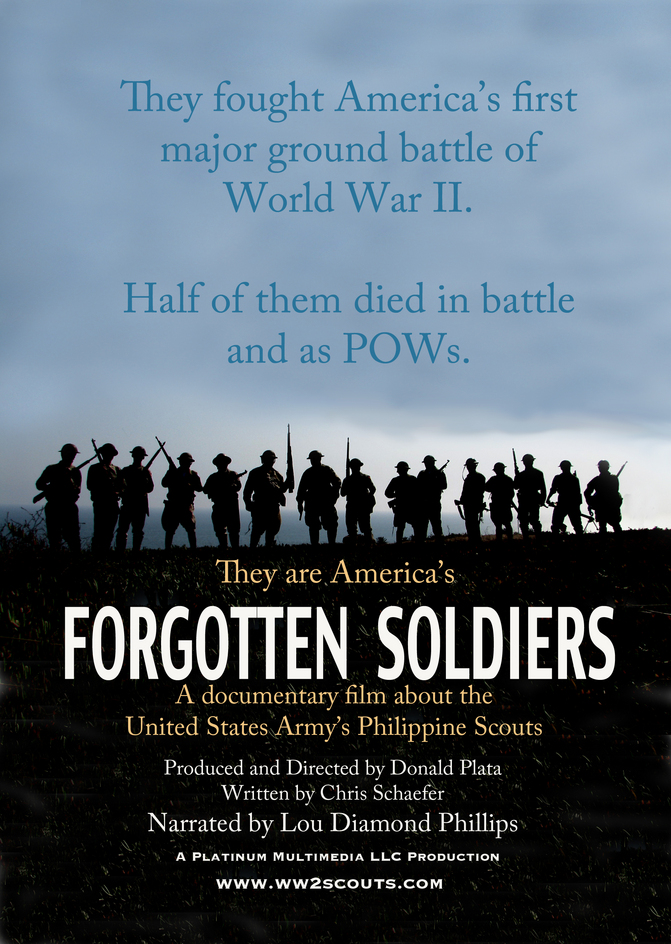Filtered By: Lifestyle
Lifestyle
Movie review: 'Forgotten Soldiers' docu sheds light on the Philippine Scouts
Text and photo by MIKHAIL LECAROS
On April 10th, 2012, a packed house of World War II veterans, diplomats, historians and invited guests were on hand at the Greenhills Promenade’s Teatrino to witness the Manila premiere of “Forgotten Soldiers”, a documentary film by first-time director Donald A. Plata.

The product of six years’ hard work and extensive research, the film is a tribute to the fighting spirit of a little-known military unit that formed the backbone of General Douglas MacArthur’s forces in Bataan and Corregidor. While Singapore, Malaysia, Hong Kong and Thailand succumbed to the Japanese war machine in mere days, members of this elite fighting unit were able to coordinate and lead poorly-trained Philippine Army troops and inexperienced members of the US National Guard, enabling them to hold out for over four months. Without reinforcements, supplies or support from their commanders half-a-world away, this unit’s actions would earn its members the first three US Congressional Medals of Honor awarded in World War II. This unit was the Philippine Scouts.
“Historically, everyone knows about the experiences of minorities in the US Military,” said Plata, on his motivations in creating the film. “There are many materials about the Tuskegee Airmen, Navajo Code Talkers and even the Buffalo Soldiers, but when it came to the Philippine Scouts, there was practically nothing! So I decided, while the veterans are still with us, to do the research and make my own.”
Formed in 1902, the Philippine Scouts was made up of Filipinos under the command of American officers. In 1919-1920, the Scouts’ various companies were officially integrated into the US Army and divided into Infantry, Field Artillery, Cavalry and Coastal Artillery Regiments. By the time of the United States’ entry into the Second World War, the Philippine Scouts were MacArthur’s frontline troops in the Pacific Theater.
Uniformed members of the Philippine Scouts Heritage Society at the screening of 'Forgotten Soldiers'. Photo by Mikhail Lecaros
From the beginning of hostilities in December 1941 to the American surrender at Corregidor, the Scouts were responsible for more enemy casualties than any other unit at that time. Their efforts not only occupied the enemy long enough for the US to make progress in rebuilding its devastated Pacific fleet, but the time and resources the Japanese were forced to devote to the Philippines prevented them from invading Australia.
“It’s true,” says Sergeant First Class (Ret.) Dominador “Dan” Figuracion, who attended the premiere. At 92 years of age and proudly decked out in full uniform, complete with hat, he certainly cut a striking figure. His livery identified him as a Scout with the fabled 26th US Cavalry, which holds the distinction of having carried out the last horse-mounted cavalry charge in US military history against the advancing Japanese. “We definitely weren’t Boy Scouts, and the enemy knew this. If you were there (in the Bataan Death March) and wearing the uniform of a Scout, you were tormented, you were tortured more. We lost a lot of people.”
Comprised of interview footage, archival materials and historical reenactments and featuring narration by actor Lou Diamond Philips, “Forgotten Soldiers” is an independently-funded and -produced documentary. What the production lacks in overall gloss, however, is more than made up for by the human element it brings to a dark period of our collective national history.
Well-documented battles and skirmishes are represented here, including the aforementioned last-ever mounted Cavalry charge, but it is in the smaller stories, such as one detailing the fates and names of those soldiers’ horses, that the film earns its stripes. It was impossible not to be moved as the veterans onscreen and in the audience began tearing up while recalling how, when faced with starvation, they were ordered by their officers to send their faithful steeds off to the slaughterhouse.
A significant portion of the film’s runtime is devoted to the inhuman conditions prisoners were subjected to following the American surrender. Upon completing the brutal Bataan Death March, prisoners were interned at the infamous Camp O’Donnell. Lack of food, medicine and inadequate facilities (60,000 prisoners in a facility built for 10,000) meant that malnutrition and disease would be the leading causes of death over the next nine months. All told, with an average rate of 400 prisoners dying every day, 26,000 Filipinos lost their lives within the walls of Camp O’ Donnel.
When the credits ran and the lights came on, the audience was on its feet, offering a prolonged standing ovation, as much to the filmmakers as to the veterans in attendance, to say nothing of their fallen comrades-in-arms. Young and old, local and foreign, the guests were affected by the film, and moved to meet the men the documentary’s creators had chosen to honor. Pictures were taken and handshakes exchanged, as the former defenders of their generation stood to receive well-deserved adulation and gratitude.
While what Plata and company have created here may not go down as the definitive word on the topic, the sheer effort and passion they put in will serve as a remarkable step toward ensuring that these men, these Philippine Scouts and their sacrifices will remain “Forgotten” nevermore. — TJD, GMA News
For the trailer and information on future screenings of “Forgotten Soldiers”, please visit www.ww2scouts.com. For more information on the Philippine Scouts and World War II, please visit the Ortigas Library Foundation (www.ortigasfoundationlibrary.com.ph), the Lopez Memorial Museum and Library, and the Philippine Scouts Heritage Society (www.philippine-scouts.org)
More Videos
Most Popular



